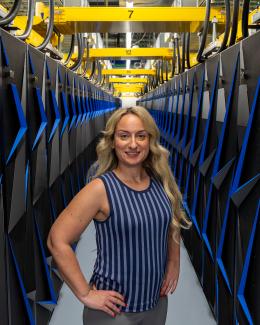Poster Session Chairs
Poster Session Speakers
Poster Presenters

Dr. Philip Dee, ORNL
Eugene P. Wigner Distinguished Staff Fellow
Poster Title: Accelerating Discoveries in Quantum Materials Using Machine Learning Augmented Many-body Approaches
Machine learning is powering a new wave of advances in quantum many body research by accelerating solvers, generating synthetic data, optimizing workflows, and more. Surrogate models now predict forces or energies for updates on the fly, lowering autocorrelation times in quantum Monte Carlo and molecular dynamics runs while retaining their nonperturbative accuracy. On the data side, rapid diagrammatic approximations can be chained into cost-effective pipelines that produce large, labeled datasets—fuel for training models that interpret spectroscopic experiments in real-time. We will survey our ongoing work on both fronts. First, we present self-learning hybrid Monte Carlo for a 2D electron–phonon model to learn forces in a quantum model. Second, we describe a framework that stitches together fast, perturbative solvers to create diverse training corpora, enabling ML models to deliver instant, physically constrained feedback on experimental datasets. Together, these advances chart a route toward routine, high‑resolution exploration of quantum materials.

Dr. Ayana Ghosh, ORNL
Poster Title: Physics-guided causal reasoning for complex material systems
Traditional computational methodologies such as density functional theory (DFT), molecular dynamics, Monte Carlo simulations have long guided the study of complex materials. Today, the integration of AI/machine learning (ML), high-performance computing, with real-time theory-experiment loops is transforming this process—enabling autonomous discovery and optimization. We present a multifaceted framework combining first-principles simulations, ML, proxy theory design, infused with causal reasoning to explore complex physical phenomena such as cation ordering, polarization switching alongside emergent behaviors in perovskites, two-dimensional materials. A key focus is developing and adapting causal models—using algorithms like LiNGAM, PC—tailored to incorporate physical constraints, domain knowledge, enabling us to move beyond surface correlations to uncover underlying mechanisms. By embedding causal frameworks into ML pipelines, we seek to enhance interpretability, improve generalization, thereby enabling actionable scientific insights. This paradigm is aimed to accelerate closed-loop materials design while advancing our fundamental understanding of complex physical systems.

Dr. Matthias Heinz, ORNL
Eugene P. Wigner Distinguished Staff Fellow
Poster Title: Leadership computing for atomic nuclei and fundamental physics
Atomic nuclei are essential probes for fundamental physics, particularly for possible new physics beyond the standard model. Theoretical predictions for the properties of these nuclei are required to identify and interpret rare events being searched for in high-precision experiments across the globe. Precise and robust predictions require large-scale first-principles computations. We are developing leadership computations for the structure of deformed nuclei to predict key properties relevant for the possible discovery of new fundamental physics.

Dr. Paul Kairys, ORNL
Alvin M. Weinberg Distinguished Staff Fellow
Poster Title: Entangling Neutron and Quantum Science
Quantum technologies are anticipated to significantly increase the rate and quality of science by providing fundamentally new avenues for processing, sensing, and communicating information. This ongoing work is concentrated upon the design of a quantum simulation and metrology framework for neutron sciences. It’s focus is to define and characterize quantum algorithms for adaptive neutron scattering experiments and produce a quantitative analysis of the metrological utility of entangled neutron scattering in the study of quantum materials.
| Poster Presenter | Subject Area | Poster Title | Poster Abstract |
| Yejoon Ham, Bearden High School, Knoxville, TN High School Student | Artificial Intelligence | ML-Based Propylene Yield Prediction in Thermo-Catalytic Propane Dehydrogenation | Propane dehydrogenation is a chemical process used to convert propane into propylene, an important compound in plastic production and manufacturing. Applying Joule heating with pulsed heating and quenching is an emerging technology that leverages an electrical potential gradient to perform catalytic dehydrogenation. To predict conversion and selectivity to optimize yield, AI/surrogate models such as machine learning, deep learning, and ensemble models were trained on experimental data. Despite limited sample data, random forest saw high accuracies when using peak temperature, heating and quenching time, and voltage as inputs. Using hyperparameters tuned with 5-fold cross-validation, it boasted an out-of-bag (OOB) score of 85–90%. Ensemble models built on diverse base models consistently performed around 90% in analyzing catalysts’ elemental composition for both conversion and selectivity. These findings indicate AI models are a viable, predictive technology for optimizing Joule heating and propane dehydrogenation processes. |
| Maggie Miller, Bearden High School, Knoxville, TN High School Student | Artificial Intelligence | Brain Abnormality Detection Using Convolutional Neural Networks | Tumors, strokes, and infections can cause irreversible damage or death without prompt diagnosis. Limited access to expert radiologists and slow manual MRI analysis delay critical treatment. This study explores Convolutional Neural Networks (CNNs) to automate and accelerate accurate diagnosis of these conditions. |
| Dominick Pelaia, High School Student | Artificial Intelligence | AI-Driven Evaluation of Compounds for Mitigating Alzheimer’s Disease | Alzheimer’s disease (AD) is driven by complex biological processes including amyloid-beta aggregation, tau hyperphosphorylation, neuroinflammation, and oxidative stress. To support the discovery of multi-target therapeutic compounds, we developed a novel dataset and machine learning pipeline linking small molecules to AD pathological pathways. Using a Python-based workflow, we extracted gene targets from GeneCards and retrieved corresponding bioactive compounds and molecular descriptors from ChEMBL, including SMILES strings and activity data. We then trained a neural network using PyTorch and RDKit to predict the probability that a given compound influences each of the four major AD pathways. Our model outputs four pathway probabilities for each compound, helping to prioritize molecules with broad or targeted biological potential. The model achieved 99.1% accuracy on test data and was applied to 100 natural compounds, with several results supported by findings in existing literature. This approach demonstrates how AI can guide early-stage drug discovery research. |
| Channing Tan, University of Tennessee, Knoxville Undergraduate Student | Artificial Intelligence | Spatial-temporal GNN based Zone Load Forecasting for Texas Electricity Market | Accurate short-term electricity load forecasting is essential for electricity producers to submit competitive bids in market transactions and for Distribution System Operators to ensure efficient economic dispatch. This project focuses on developing a one-hour-ahead load prediction model for the Electric Reliability Council of Texas (ERCOT) region. While traditional forecasting methods and existing artificial intelligence techniques have been widely applied, many fail to capture spatial dependencies inherent in regional load patterns. To address these limitations, this study explores the use of Graph Neural Networks (GNNs) for enhanced prediction accuracy. A graph-based representation of the ERCOT network is constructed using the geographical layout of its eight weather zones. Spatial-temporal attention mechanisms and various GNN layer architectures are investigated. The proposed model leverages publicly available historical load and weather data and is benchmarked against classical forecasting approaches to evaluate its performance. |
| Damien Staebler, Pellissippi State Community College, Knoxville, TN Undergraduate Student | Artificial Intelligence and High Performance Computing | Establishment of a Histopathological Image Analysis Pipeline on the Frontier Supercomputer | Histopathology has traditionally been analyzed manually, but recent advances in technology now enable the use of Machine Learning models to accelerate this process through Whole Slide Imaging (WSI). However, a major challenge is the enormous size of each WSI file—often several gigabytes—which makes them computationally intensive to process using conventional methods. To address this, we leveraged High-Performance Computing to handle large-scale data efficiently. Each WSI is first preprocessed by removing the background and retaining only the tissue regions. The tissue is then divided into multiple non-overlapping patches of 256×256 pixels, which collectively form a “bag” for analysis. Each patch is processed through a ResNet50 convolutional neural network to extract feature embeddings, which are then combined into a single feature vector used for WSI-level classification. By utilizing the Frontier supercomputer, we achieved a classification accuracy of 98%, along with an approximate 40,000 times speedup compared to standard workstation performance. |
| Nasik Muhammad Nafi, Oak Ridge National Laboratory Postdoc Research Associate | Artificial Intelligence, Material Science | Enabling Multimodal Microstructure Image Generation through Vision Transformer-based Scalable Diffusion Model | Analyzing the microscopic structure of materials — that denotes its physical and mechanical properties — is essential to understand the structure-property relationship, optimize the manufacturing processes, and design materials with intended functionalities. However, microstructure imaging in high resolution is often very costly and time-consuming due to sophisticated instrumentation and long acquisition time. To address this, we developed a scalable generative model that can generate microstructure images conditioned on the material (polycrystal, concrete) and the modality (X-ray and Neutron Computed Tomography (CT), Electron Microscopy, etc.). We integrated an efficient Vision Transformer (ViT) architecture with a diffusion-based generative model. Such integration allows us to simultaneously leverage the scalability and self-attention mechanism of transformers as well as the benefits of diffusion models such as stability and high-quality output. Our initial experimentation with different modality and materials shows promising results in capturing accurate structural representation using reasonable computing resources. |
| Ran Elgedawy, University of Tennessee, Knoxville Graduate Student | Applied AI | Enhancing Safety at DOE Sites through Predictive AI | The ORNL AI Forecasting Tool is an advanced artificial intelligence framework developed to improve operational safety at Department of Energy (DOE) facilities. It targets two key challenges: predicting and preventing incidents through risk analysis, and reducing human error in safety documentation. The system supports two main applications. The first uses a structured AI workflow to forecast risks by analyzing current work plans and retrieving patterns from 65,000 historical DOE incident records. It includes four core components: Work Plan input processing, Information Retrieval, Risk Analysis using large language models, and Safety Standards Integration with ORNL’s Standards Based Management System to ensure compliance. The second application automates Activity-Based Work Control (ABWC) document generation for Chemical Sciences, replacing labor-intensive manual processes with a generative AI system linked to PubChem databases. This proof of concept significantly improves accuracy and efficiency, laying the groundwork for a conversational AI interface to streamline ABWC-Chemistry safety documentation further. |
| Cindy Salinas Avelino, University of Tennessee, Knoxville Undergraduate Student | Computational and Predictive Biology | From Doubt to Data: Mapping Poplar-Microbe-Environment Networks | “Poplar (Populus trichocarpa) is a widely distributed resource across the U.S. and is vital to biofuel production, though its productivity remains sensitive to climate variability. Among the climate factors affecting productivity, drought is one of the most influential. Ilyonectria colonization in plants impacts cellular metabolic and mechanistic functions. Because Ilyonectria is heavily influenced by environmental conditions, understanding this interaction is key to promoting plant growth and adaptation. Network-based tools such as Multiplex Embedding of Networks for Team-Based Omics Research (MENTOR) and large language models (LLMs) like the Mentor Interpretation Agent (MENTOR-IA) are instrumental in mapping interactions among microbes, the environment, and plant genetics by integrating GWAS with multi-omics data. In this project, we explore how this approach accelerates plant gene discovery by biologically contextualizing multi-omic data—transforming uncertain hypotheses into clear insights!” |
| Colter Richardson, University of Tennessee, Knoxville Graduate Student | Computational Astrophysics | Low-Frequency Gravitational Waves from Core-Collapse Supernovae: Theory and Detection Prospects | The low-frequency contribution to gravitational wave signals from core-collapse supernovae has often been overlooked due to the rapid increase in the LIGO noise floor at 10 Hz, but recent studies have illuminated the rich content of core-collapse supernova gravitational wave emission in this frequency range and the exciting prospects for its detection. Here, I will present a brief review of these past studies. I will also present our methodology for the detection of core-collapse supernova gravitational wave memory, utilizing matched filtering, as well as the low-frequency gravitational wave emission sourced from both the matter and the anisotropic neutrino emission in the three-dimensional models of the CHIMERA group, associated with the most recent release of gravitational wave data from that group. |
| Cheng-Hsin Cheng, University of Illinois Urbana-Champaign, IL Graduate Student | Computational Astrophysics | Compact object initial data in Flash-X | Neutron stars are astrophysical laboratories where the properties of dense nuclear matter can be probed in a regime inaccessible by terrestrial experiments. The gravitational and electromagnetic signals resulting from the merger of neutron stars can be predicted through numerical simulation, a problem requiring solving Einstein’s Equations of general relativity coupled to general relativistic hydrodynamics and neutrino radiation transport. The initial data for these simulations are highly non-trivial and require the solution of coupled non-linear elliptic partial differential equations. Using spectral elliptic solvers provided by FUKA, we construct compact object initial data and interface it with the newly developed numerical relativity unit in Flash-X. Our work paves the foundation for numerical relativity simulations of binary neutron star and black hole neutron mergers with realistic microphysics and neutrino radiation transport at scale using Flash-X. |
| Alyvia Bitterly, Roane County High School, TN High School Student | Data Science/ Machine Learning | The Great Texas Power Outage Study | The goal of this project was to explore patterns between the frequency of power outages and natural events. Using the Department of Energy’s EAGLE-I Power Outage Database and resources at the Oak Ridge Leadership Computing Facility, we applied K-Means clustering to group outages over the past five years by U.S. location and time of year. We then used a deep learning method called Long Short-Term Memory (LSTM), a type of Recurrent Neural Network, to predict outages for the last year of the dataset and compared peaks in the predictions to K-Means cluster centroids by season. I tested an existing K-Means implementation developed by Thomas J. Fillers as part of a student training activity and worked with my mentors to develop and apply the LSTM model. While we didn’t directly link outages to specific weather events, our results suggest that long-term outage data follows seasonal, region-specific cycles—similar to natural weather patterns. |
| Nabayan Chaudhury, Virginia Tech University Graduate Student | High-performance computing, Supercomputing, Scientific computing | Adaptive Task Scheduling for Performance-Portable Scientific Computing on Extremely Heterogeneous Systems | Achieving performance portability across extremely heterogeneous systems remains a critical challenge for computing applications. We present an adaptive task scheduling framework that can maximize performance through intelligent work distribution on task-based runtime systems, integrating UniSYCL with the IRIS runtime to enable automatic task splitting and scheduling across diverse accelerators. The core contribution is a set of scheduling algorithms that partition parallel workloads based on device performance characteristics to achieve optimal load balancing. We analyze task parallelizability, extract iteration spaces, and creates device-specific subtasks that execute concurrently across all available accelerators. By adaptively calculating proportional work distributions, the scheduler minimizes overall execution time while maintaining perfect synchronization. Through SYCL’s unified programming model, our expectation is that a single source code will achieve near-linear scalability across heterogeneous devices including NVIDIA and AMD GPUs. This work enables transparent exploitation of heterogeneous parallelism in task-based systems, critical for maximizing computational throughput on modern HPC architectures. |
| Heber Rocha, Indiana University | High Performance Computing | Human-Interpretable Grammar for Multiscale Agent-Based Models: Building the Foundations for Robust Cancer Patient Digital Twins | Multiscale agent-based models (ABMs) are powerful tools for simulating complex tumor–immune dynamics, yet their adoption and reproducibility are often hindered by steep technical barriers, inconsistent documentation, and difficulties in sharing model logic. We present a human-interpretable grammar for multicellular systems biology, recently integrated into the PhysiCell framework, that encodes ABM rules and parameters in a transparent, modular, and shareable format. This approach democratizes the creation of virtual laboratories, allowing researchers to build, modify, and reproduce complex simulations without deep programming expertise. Such capabilities are critical for advancing cancer patient digital twins (CPDTs)—computational representations of individual patients aimed at guiding precision oncology. Previous CPDT studies have highlighted persistent challenges, including biological variability, parameter uncertainty, and limitations in patient stratification. By combining interpretable grammars with high-throughput computational strategies for uncertainty quantification and calibration, we outline a pathway toward more robust, collaborative, and clinically relevant CPDT development. |
| Jakob Bludau, Oak Ridge National Laboratory Postdoc Research Associate | High Performance Computing | Understanding GPU Energy Dynamics in HPC Applications | Modern graphic processing units have varying power demands for computation and memory operations. Therefore, different implementations of the same algorithm can have different power profiles and consequently energy demand even if they have the same runtime and result for the user. To allow comparison of algorithms leveraging the Kokkos performance portability library, we implemented a new power measurement tool that gives users direct insight into the power and energy profiles of the algorithms they run. This tool allows to optimize runtime and energy consumption simultaneously and can be used portably for different GPUs used in HPC. |
| Ethan Puyaubreau, Paris Saclay University, France Undergraduate Student | High Performance Computing | Understanding GPU Energy Dynamics in HPC Applications | Modern graphic processing units have varying power demands for computation and memory operations. Therefore, different implementations of the same algorithm can have different power profiles and consequently energy demand even if they have the same runtime and result for the user. To allow comparison of algorithms leveraging the Kokkos performance portability library, we implemented a new power measurement tool that gives users direct insight into the power and energy profiles of the algorithms they run. This tool allows to optimize runtime and energy consumption simultaneously and can be used portably for different GPUs used in HPC. |
| Tatiana Melnichenko, University of Tennessee, Knoxville Undergraduate Student | High Performance Computing | Mojo: a Python-like, productive language for GPU-portable scientific high-performance computing | GPUs power most of the world’s fastest supercomputers and are central to modern AI breakthroughs. However, developing GPU-accelerated code remains challenging for many domain scientists. We evaluate Mojo, a new Python-like programming language, designed to bridge the gap between Python’s high productivity and the performance demands of modern computing. Mojo builds on MLIR, a modern compiler infrastructure adopted by all major vendors, enabling code portability between NVIDIA and AMD GPUs. Our work benchmarks Mojo against vendor-specific C++ implementations (CUDA and HIP) on four representative scientific workloads: a 7-point stencil, BabelStream, Hartree-Fock, and miniBUDE. These span memory-bound, compute-bound, and atomics-heavy kernels. We conducted tests on NVIDIA H100 and AMD MI300A GPUs. Our results show that Mojo delivers GPU-portable performance comparable to vendor-specific C++ code. Although Mojo is still evolving and requires familiarity with some low-level concepts, it shows strong potential for portable high-performance computing. |
| Elle Brinkman, University of Tennessee, Knoxville Undergraduate Student | HPC Theoretical Astrophysics | Analysis of Core Collapse Supernovae Through Neutrino Signals from Flash-X Simulations | Core collapse supernovae (CCSN) signal the deaths of massive stars as well as the births of neutron stars and black holes. They are also the source of many important elements in the universe, including elements essential for life. CCSN generate rare transient signals in gravitational waves and neutrinos that we can analyze in order to understand the properties of the star before it exploded. Our project focuses on the neutrino signatures from state of the art Flash-X / Thornado simulations. These simulations follow all six neutrino species: Electron, Muon, Tau neutrinos and their respective anti-neutrinos. Each of these species have different properties and as a result, provide different information about the supernova. We conducted analysis on the neutrino signals of these six species to understand CCSN phenomena more completely. By learning more about how different neutrino signatures reflect the properties of the star and its CCSN from simulations, we are able to interpret neutrino signals from CCSN that we detect in the real world more effectively. |
| Violet YarKhan, L&N STEM Academy, Knoxville, TN High School Student | Material Science | Parallelized Validation of Fluid Simulation | We found the hidden structure of liquid water by segmenting a virtual box and mapping oxygen to oxygen interactions at the atomic scale. Given the scale of data, the previously used serial methods of verification prove too slow to be helpful for many tasks. |
| Khadija Alnaggar, Farragut High School/University of Tennessee, Knoxville Rising Freshman Undergraduate Student | Molecular Dynamics, Biological and computational sciences | Analyzing the Effect of Timestep on Bilipid Membrane Simulations | We investigated how the choice of molecular dynamics timestep affects key physical properties of a simulated membrane. We constructed a membrane based on 1-palmitoyl-2-oleoyl-sn-glycero-3-phosphocholine (POPC) using VMD, and simulated the hydrated membrane across timesteps of 0.5, 1.0, 2.0, and 2.5 fs using NAMD. Analysis of membrane thickness and area-per-lipid head-group showed major discrepancies from published data. To rule out glassy dynamics, we analyzed movement of the lipid head-group and confirmed that dynamics was diffusive. We inferred poor initial packing allowed water to infiltrate the bilayer unphysically, causing divergence from published data. We rebuilt the system using a more extensive, multi-step relaxation process. This better preserved membrane structure, producing membrane thickness and area values closer to published results. Importantly, we find statistically significant differences versus the simulation timestep. These findings highlight the importance of simulated membrane properties on packing and timestep used in simulations. |
| Salatiel Martinez, University of Michigan-Dearborn Undergraduate Student | Parallel Computing | Parallelizing Steps Process in Celeritas | The current Celeritas implementation for simulating electromagnetic particles on GPUs suffers from a bottleneck due to its serial execution pattern. This serialization of steps leads to slow interaction with Geant4 and significant CPU idle time while waiting for GPU operations to complete. We present a novel paral- lelization approach using NVIDIA CUDA streams to address these limitations. By decomposing the step sequence into smaller sufficiently atomic actions and orchestrating their execution across two dedicated streams—one for kernel operations and one for memory copy operations—we achieve significant improvements in throughput and resource utilization. Our prototype demonstrates that steps can be overlapped across streams while avoiding data dependency conflicts, resulting in an improved step completion time. The parallelization pattern enables concurrent handling of actions within steps, improving GPU utilization and reducing CPU idle time, thus providing more efficient execution with Geant4. This work establishes a foundation for future exploration of multi-stream parallelization in Celeritas. |
| Kaiser Ramjee, Webb School of Knoxville, TN High School Student | Quantum | Variational Quantum Eigensolver Simulations for Multi-Qubit Ising Models | Variational quantum eigensolvers (VQEs) are hybrid quantum-classical algorithms utilizing parameterized quantum circuits and classical optimization cost functions to determine the ground state of a given physical system. In this project, VQEs were used to determine the ground state energy and magnetization of two-qubit and four-qubit quantum transverse field Ising models. The accuracy of the VQE solution was compared to a classically-determined ideal ground state solution. Additionally, we examined the efficiency and efficacy of various ansatz circuits, each with 16 parameters. Efficiency was measured by comparing the average number of iterations before convergence for each type of ansatz. The average percent error between the ansatz and the classical solution was also compared. The Quantum Approximate Optimization Algorithm (QAOA) was determined to be the most efficient ansatz for the two-qubit model. Further investigations seek to study the use of VQEs for more complex spin models with different particle interactions. |
| Isaac Lawrie, High School Student, Knoxville, TN | Quantum | Saving Qubits with Variational Nonorthogonal Quantum Optimization | Current quantum computers are facing challenges due to their limited number of qubits and substantial gate noise, hindering their ability to solve practical real-world computational problems. To save qubit resources, we study a variational nonorthogonal quantum optimization algorithm and apply to solve integer optimization problems, where p different integer values are encoded in a single qubit. After executing parametrized quantum circuit ansatzes, we decode these integer values by performing simultaneous quantum state tomography on each qubit. Numerical simulations are conducted for p=4 (tetrahedron vertices) and p=20 (dodecahedron vertices), where classical values are encoded at these vertices on the Bloch sphere. Exact solutions are obtained with only a moderate number of variational parameters. Our demonstration shows this a promising algorithm suitable to benchmark ORNL’s first on-premises quantum computer consisting of three 2-qubit, room-temperature, diamond-based QPUs developed by Quantum Brilliance, as well as to explore quantum-HPC hybrid workflows. |
| Jax Grzywacz-Jones, L&N STEM Academy, Knoxville, TN High School Student | Quantum Computing | Saving Qubits with Variational Nonorthogonal Quantum Optimization | Current quantum computers are facing challenges due to their limited number of qubits and substantial gate noise, hindering their ability to solve practical real-world computational problems. To save qubit resources, we study a variational nonorthogonal quantum optimization algorithm and apply to solve integer optimization problems, where p different integer values are encoded in a single qubit. After executing parametrized quantum circuit ansatzes, we decode these integer values by performing simultaneous quantum state tomography on each qubit. Numerical simulations are conducted for p=4 (tetrahedron vertices) and p=20 (dodecahedron vertices), where classical values are encoded at these vertices on the Bloch sphere. Exact solutions are obtained with only a moderate number of variational parameters. Our demonstration shows this a promising algorithm suitable to benchmark ORNL’s first on-premises quantum computer consisting of three 2-qubit, room-temperature, diamond-based QPUs developed by Quantum Brilliance, as well as to explore quantum-HPC hybrid workflows. |
| Seongmin Kim, Oak Ridge National Laboratory Postdoc Research Associate | Quantum, HPC, AI | Accelerating Distributed Quantum Optimization with GPUs on HPC–Quantum Architectures | Quantum computing holds promise for efficiently solving complex combinatorial optimization problems across diverse scientific fields. The Distributed Quantum Approximate Optimization Algorithm (DQAOA) has been proposed to address high-dimensional optimization challenges by integrating current quantum computing techniques with high-performance computing (HPC) systems. In this work, we enhance the scalability and performance of DQAOA by incorporating advanced problem decomposition strategies and exploiting multicore and multinode parallelism via the Message Passing Interface (MPI) on the Frontier CPU/GPU supercomputer. By distributing QUBO problem instances across classical and quantum resources, our framework enables efficient orchestration of quantum-classical workloads and optimal utilization of heterogeneous computing resources. Our results show that GPU-accelerated DQAOA achieves up to a 10× speedup over its CPU-only implementation, significantly improving scalability for large problem instances. This study demonstrates the potential of GPU-based HPC systems in advancing quantum-classical hybrid optimization and paves the way for practical deployment of large-scale quantum-enhanced algorithms on emerging HPC–quantum platforms. |
| Sheikh Md Mushfiqur Rahman, Boise State University, Idaho Graduate Student | Software Engineering | Exploring Sustainability in Scientific Software Through Code Quality Metrics | Scientific open-source software is essential to research and engineering, yet its long-term sustainability is often overlooked. In this study, we analyze projects from the CORSA catalog, a curated collection of scientific software, to assess sustainability based on multiple indicators of sustained development activity. We classify projects as sustainable or unsustainable, and compare them using structural code metrics and test coverage. Sustainable projects exhibit higher and more consistent test coverage, along with stronger correlations between code structure and test quality. In contrast, unsustainable projects show weaker patterns and lower coverage. Overall, testing remains limited across the dataset, with high complexity and coupling linked to reduced testability. Our work offers a data-driven framework to evaluate scientific software sustainability and support long-term quality assurance. |



